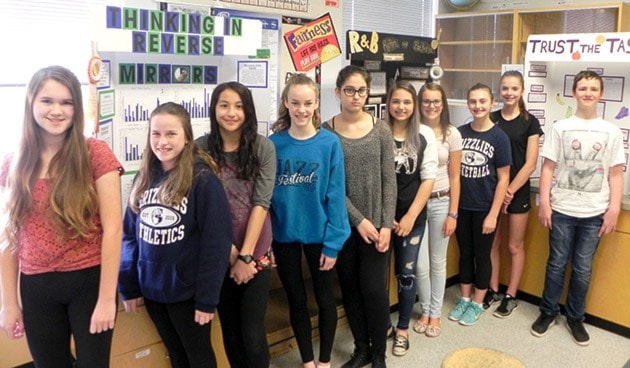Kennedy Campbell admits she hasn’t always warmed up to science.
But when she started taking Grade 7 science at GW Graham, something about the class sparked an interest. Now, that little spark is burning like a flame over a bunsen burner.
Campbell’s been selected as one of three Fraser Valley teens that will travel to Montreal in May for the Canada-Wide Science Fair. She was selected as one of three winners of the Fraser Valley Regional Science Fair in Abbotsford on March 30, along with two other students from Langley and Abbotsford. The trio will join winners from 100 regions, all of who will pack up their science projects and embark on an all-expenses-paid scientific and educational journey.
Campbell’s not entirely sure why the judges chose her submission over the others. But she’s happy to explain the project, called Thinking in Reverse, and how it came to be. Like all great science projects, it’s beginnings began with a simple observation.
“I saw an ambulance,” she says. But more precisely, she noticed the word ‘ambulance’ on the front was written backwards. That prompted some questions about mirrors, eyesight, and how the brain works.
In short, she had the basic outlining of her science project.
Her finished project checks off all the requirements of the scientific method, from a purpose and a hypothesis, to a procedure that includes dependent and independent variables, results, and a conclusion.
She had volunteers first draw a line through an easy course on paper, and timed that result. Then, she had them look at that same course via a mirror. The results? It took about 10 times longer for the volunteers to make it through the course when they were looking at it through a mirror.
While she had suspected her older volunteers with driving experience would fair better on the mirrored course, she was wrong. What she did find was that female volunteers faired better, with faster times.

So, a simple question discovered in daily life had become a well-thought-out science project — complete with clear graphs, intricate drawings, and an easy to read format.
Clearly a winner. But she wasn’t the only one at GW to win attention from the judges.
Students at GW Graham had been asked to think about potential science project subjects over the Christmas break. When they arrived back in January, they got to work.
Several students took part in the regional fair, and many came up with a project that related to them personally somehow.
Montana McCrae and Maria Trotskyi delved into the effects of music on bacteria, winning a silver ribbon for their ideas. For the curious readers out there, classical music has the strongest effect on bacteria, which the girls believe shows the ‘Mozart effect.’ Mackenzie Campbell was inspired by her parents’ professions as opticians, and Carmen Migic chose to learn more about dementia, to understand a family member better.
Winning bronze at the regionals was Tori Fedrau, Ava Kauppi, Sydney Dombowsky and Aliza Dueck, Hannah Rachey, and Campbell. And while the projects of Migic and Trevor Batchelor weren’t awarded medals, their projects equally impressed GW science teacher Tammie Chernoff.
“When I think about the subject science, one word comes to mind and that is curiosity,” she says. “Students have a natural curiosity about the world around them. The study of science gives students a framework for understanding and making sense of their environment. What I love about the science fair is students have the ability to choose their topic. They explore their topic through the framework of the scientific method. They become so immersed in their topics. And the topics are so diverse.”
Some of the topics GW Graham students explored included dementia, tribology, sight, and dreams. There’s room for all subjects in science, because as Chernoff points out, science is everywhere. And traveling to science fairs can get students excited about the world around them, too.
“The science fair fosters creativity, innovation, and helps students to be critical thinkers and problem solvers,” Chernoff says. “Students love the science fair. They are so engaged and they love sharing what they have learned with their classmates.”
It’s an opportunity for enrichment like no other.
And it’s also a chance to make back some of the money poured into the projects. In addition to their ribbon standings, the students took home monetary awards for their efforts.
The Canada-wide Science Fair takes place May 15 to 20.
